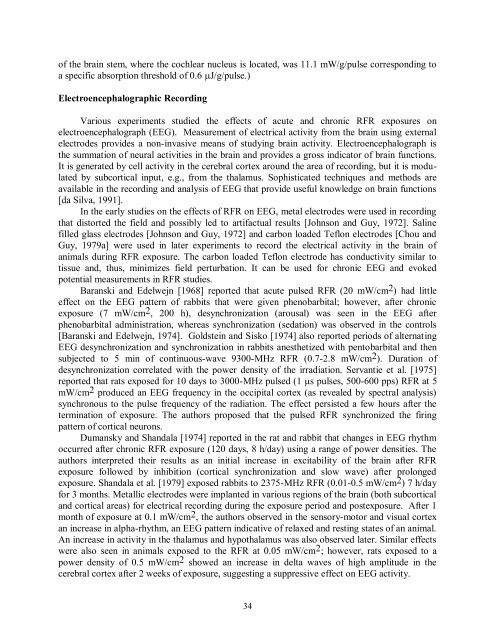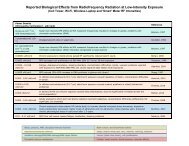Evidence for Effects on Neurology and Behavior - BioInitiative Report
Evidence for Effects on Neurology and Behavior - BioInitiative Report
Evidence for Effects on Neurology and Behavior - BioInitiative Report
You also want an ePaper? Increase the reach of your titles
YUMPU automatically turns print PDFs into web optimized ePapers that Google loves.
of the brain stem, where the cochlear nucleus is located, was 11.1 mW/g/pulse corresp<strong>on</strong>ding to<br />
a specific absorpti<strong>on</strong> threshold of 0.6 J/g/pulse.)<br />
Electroencephalographic Recording<br />
Various experiments studied the effects of acute <strong>and</strong> chr<strong>on</strong>ic RFR exposures <strong>on</strong><br />
electroencephalograph (EEG). Measurement of electrical activity from the brain using external<br />
electrodes provides a n<strong>on</strong>-invasive means of studying brain activity. Electroencephalograph is<br />
the summati<strong>on</strong> of neural activities in the brain <strong>and</strong> provides a gross indicator of brain functi<strong>on</strong>s.<br />
It is generated by cell activity in the cerebral cortex around the area of recording, but it is modulated<br />
by subcortical input, e.g., from the thalamus. Sophisticated techniques <strong>and</strong> methods are<br />
available in the recording <strong>and</strong> analysis of EEG that provide useful knowledge <strong>on</strong> brain functi<strong>on</strong>s<br />
[da Silva, 1991].<br />
In the early studies <strong>on</strong> the effects of RFR <strong>on</strong> EEG, metal electrodes were used in recording<br />
that distorted the field <strong>and</strong> possibly led to artifactual results [Johns<strong>on</strong> <strong>and</strong> Guy, 1972]. Saline<br />
filled glass electrodes [Johns<strong>on</strong> <strong>and</strong> Guy, 1972] <strong>and</strong> carb<strong>on</strong> loaded Tefl<strong>on</strong> electrodes [Chou <strong>and</strong><br />
Guy, 1979a] were used in later experiments to record the electrical activity in the brain of<br />
animals during RFR exposure. The carb<strong>on</strong> loaded Tefl<strong>on</strong> electrode has c<strong>on</strong>ductivity similar to<br />
tissue <strong>and</strong>, thus, minimizes field perturbati<strong>on</strong>. It can be used <str<strong>on</strong>g>for</str<strong>on</strong>g> chr<strong>on</strong>ic EEG <strong>and</strong> evoked<br />
potential measurements in RFR studies.<br />
Baranski <strong>and</strong> Edelwejn [1968] reported that acute pulsed RFR (20 mW/cm 2 ) had little<br />
effect <strong>on</strong> the EEG pattern of rabbits that were given phenobarbital; however, after chr<strong>on</strong>ic<br />
exposure (7 mW/cm 2 , 200 h), desynchr<strong>on</strong>izati<strong>on</strong> (arousal) was seen in the EEG after<br />
phenobarbital administrati<strong>on</strong>, whereas synchr<strong>on</strong>izati<strong>on</strong> (sedati<strong>on</strong>) was observed in the c<strong>on</strong>trols<br />
[Baranski <strong>and</strong> Edelwejn, 1974]. Goldstein <strong>and</strong> Sisko [1974] also reported periods of alternating<br />
EEG desynchr<strong>on</strong>izati<strong>on</strong> <strong>and</strong> synchr<strong>on</strong>izati<strong>on</strong> in rabbits anesthetized with pentobarbital <strong>and</strong> then<br />
subjected to 5 min of c<strong>on</strong>tinuous-wave 9300-MHz RFR (0.7-2.8 mW/cm 2 ). Durati<strong>on</strong> of<br />
desynchr<strong>on</strong>izati<strong>on</strong> correlated with the power density of the irradiati<strong>on</strong>. Servantie et al. [1975]<br />
reported that rats exposed <str<strong>on</strong>g>for</str<strong>on</strong>g> 10 days to 3000-MHz pulsed (1 s pulses, 500-600 pps) RFR at 5<br />
mW/cm 2 produced an EEG frequency in the occipital cortex (as revealed by spectral analysis)<br />
synchr<strong>on</strong>ous to the pulse frequency of the radiati<strong>on</strong>. The effect persisted a few hours after the<br />
terminati<strong>on</strong> of exposure. The authors proposed that the pulsed RFR synchr<strong>on</strong>ized the firing<br />
pattern of cortical neur<strong>on</strong>s.<br />
Dumansky <strong>and</strong> Sh<strong>and</strong>ala [1974] reported in the rat <strong>and</strong> rabbit that changes in EEG rhythm<br />
occurred after chr<strong>on</strong>ic RFR exposure (120 days, 8 h/day) using a range of power densities. The<br />
authors interpreted their results as an initial increase in excitability of the brain after RFR<br />
exposure followed by inhibiti<strong>on</strong> (cortical synchr<strong>on</strong>izati<strong>on</strong> <strong>and</strong> slow wave) after prol<strong>on</strong>ged<br />
exposure. Sh<strong>and</strong>ala et al. [1979] exposed rabbits to 2375-MHz RFR (0.01-0.5 mW/cm 2 ) 7 h/day<br />
<str<strong>on</strong>g>for</str<strong>on</strong>g> 3 m<strong>on</strong>ths. Metallic electrodes were implanted in various regi<strong>on</strong>s of the brain (both subcortical<br />
<strong>and</strong> cortical areas) <str<strong>on</strong>g>for</str<strong>on</strong>g> electrical recording during the exposure period <strong>and</strong> postexposure. After 1<br />
m<strong>on</strong>th of exposure at 0.1 mW/cm 2 , the authors observed in the sensory-motor <strong>and</strong> visual cortex<br />
an increase in alpha-rhythm, an EEG pattern indicative of relaxed <strong>and</strong> resting states of an animal.<br />
An increase in activity in the thalamus <strong>and</strong> hypothalamus was also observed later. Similar effects<br />
were also seen in animals exposed to the RFR at 0.05 mW/cm 2 ; however, rats exposed to a<br />
power density of 0.5 mW/cm 2 showed an increase in delta waves of high amplitude in the<br />
cerebral cortex after 2 weeks of exposure, suggesting a suppressive effect <strong>on</strong> EEG activity.<br />
34



